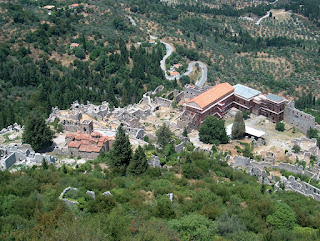Mystras
Sparta was the dominant military power in Greece from 650-371 BC, and home of the legendary King Leonidas. Modern Sparta is a far cry from the Sparta of old. There are very few ruins to explore, and not much reason to stay. The ruins of Mystras, 5 km from Sparta, however, are definately worth a look.
High on Mt Taygetos, are the three tiered ruins of Mystras. There is alot to see at this site, so be prepared to walk and bring lots of water. I spent three to four hours exploring here.


Looking at its location near the top of a mountain, one would think this an impenetrable fortress. They would be wrong. Mystras traded hands several times in its 700 year history (Byzantine, Turk, Roman, Venetian, Turk, Russian, and Albanian). By 1827, Mystras was virtually abandoned. However, some of the buildings are still in fantastic shape. The view from the top is awesome!




As I said earlier, there is not much to see in Sparta, and therefore, not much reason to stay. Although its a bit of a stretch, I made my visit to Mystras a day trip from Nafplio. This allowed me to keep Nafplio as a home base while I also visited Epidaurus and Mycenae.
Olympia
Home of the Olympic Games! I couldn't wait to get to the site. Although many of the columns were toppled by the Romans and a number of earthquakes, it was still unreal to walk around the site. The tunnel leading to the track is still in good shape, and it was really awesome to stand at the entrance and imagine that you are preparing to race. Running on the track that hosted the first Olympics is a surreal experience.


The Temple of Zeus is but a pile of rubble (damn Romans), although the size of the rubble is still impressive. Near the Temple is the workshop of Pheidias, who sculpted the enormous gold and ivory Statue of Zeus (one of the Seven Wonders of the Ancient World).




Kinda like Sparta and Mystras, apart from the Ancient Olympic site, there is not much else to see and do; therefore, no reason to stay the night.















